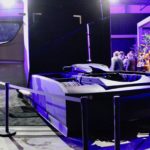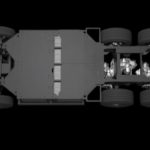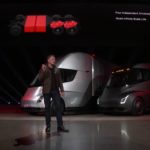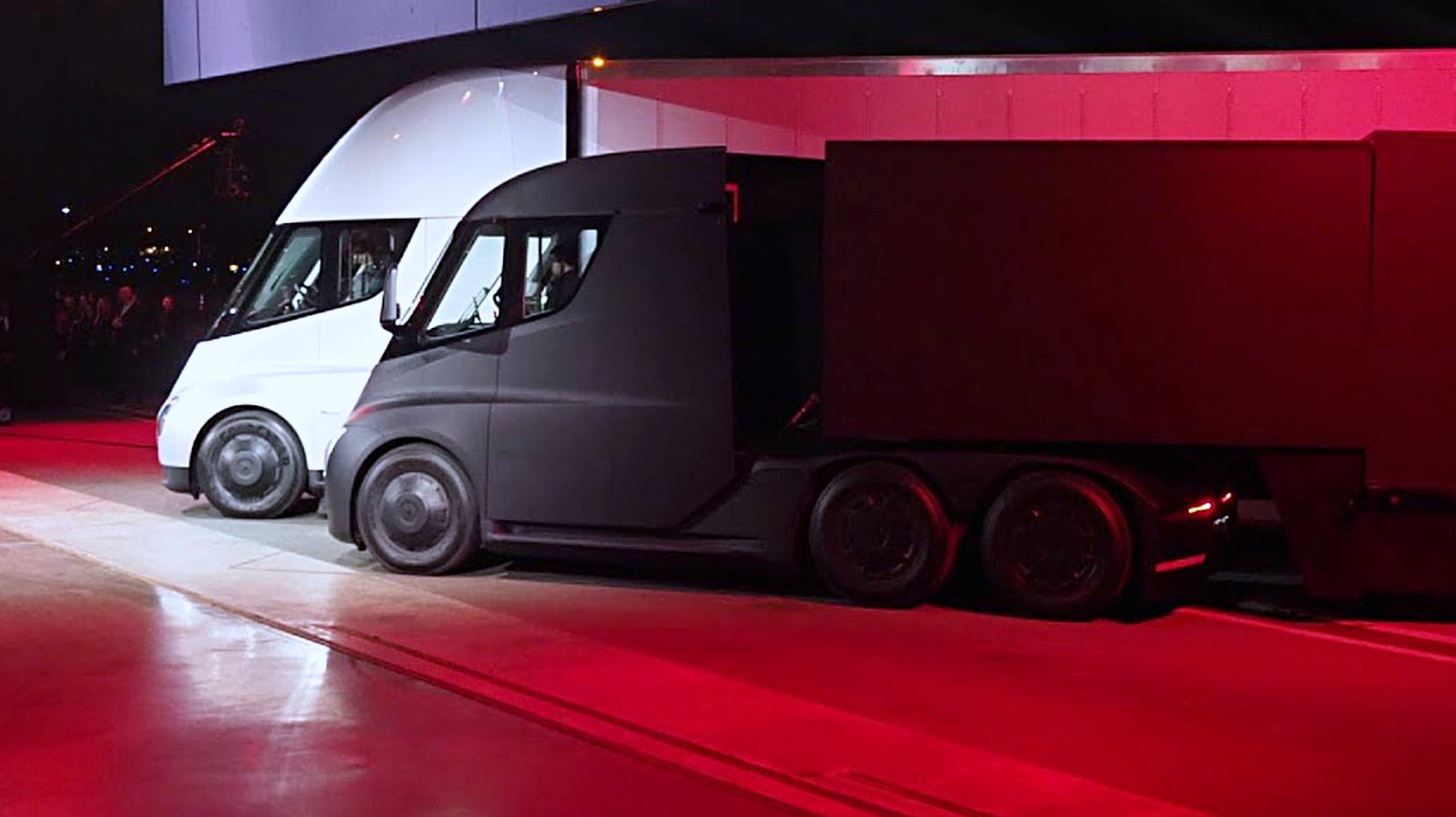
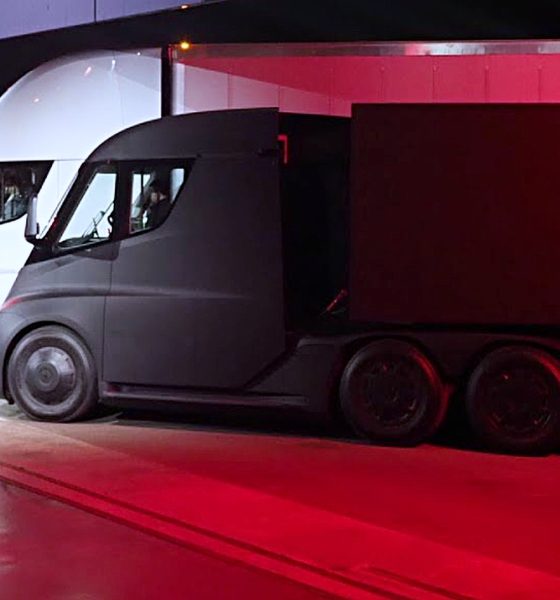
News
Tesla Semi truck’s battery pack and overall weight explored
The big question on everyone’s mind–at least on the minds of those who understand the freight transportation industry–is how much the Tesla Semi might weigh. If Tesla’s all-electric semi truck is to be competitive at all, it must be capable of carrying the same loads as current-use semi-trucks in the Class 8 field do.
A big point of contention from nay-sayers and those in the trucking industry who understand logistics was the lack of announcement of the Tesla Semi’s actual weight. Plenty of press was given to the much-touted “80,000-pound capacity” number bandied around by CEO Elon Musk during the truck’s unveiling late last year. That number, however, refers only to the gross vehicle weight (GVW) of the Tesla Semi and is, in fact, exactly the same number used by every Class 8 truck on the road. They’re called Class 8s, in fact, because the 8 refers to that 80,000-pound total vehicle capacity.
What wasn’t given by Tesla was the gross vehicle tare weight (GVTW) of the Semi. This is a far more important number. Where the GVW gives the total capacity of the truck in terms of how much its freight plus the truck itself can weigh, the GVTW gives just the weight of the truck, sans trailer and freight. This number tells logistics experts how much actual freight and trailer the truck can haul legally.
For example, a typical “day cab” configuration 18-wheeler with a diesel engine weighs roughly 32,000 pounds with a relatively lightweight box trailer attached and full fuel tanks. That leaves about 48,000 pounds of freight capacity for the truck. That’s important because, although the truck won’t be loaded to capacity every time, it will be expected to be capable of carrying up to about that weight. Most big rigs on the road are capable of hauling 44,000 or more pounds worth of freight, depending on configuration and trailer type.
Having experience with driving commercial trucks in the past, once hauling a refrigerated trailer that had a freight capacity of 44,500 pounds, I learned that some industries count on freight capacity as part of their logistics costs and will literally fill a truck to its maximum in order to minimize those costs.
In logistics, weight and total freight capacity are highly important metrics in the overall scheme.
What We Know
Thinking about that, then, let’s look at what we know of the Tesla Semi and its potential weight. We know that the truck uses four independent electric motors that are derived from the Model 3, that it has an energy consumption of less than 2 kWh per mile, and that it can be charged to up to 400 miles in about half an hour. We also know that Elon promised 300 to 500 miles of range in total. On that latter point, it’s pretty clear that a “lower range, cheaper option” will be offered as has been done with most of Tesla’s vehicles to-date. So we can assume a 300-mile version and a 500-mile version will be forthcoming for the Semi.
We also know that the Tesla Semi had eight ports in its charging plug array. We saw this at the unveil in some close-up photos.
It’s clear to us that even if the Tesla Semi isn’t to become a big player in the trucking industry, the idea behind it will change things forever.
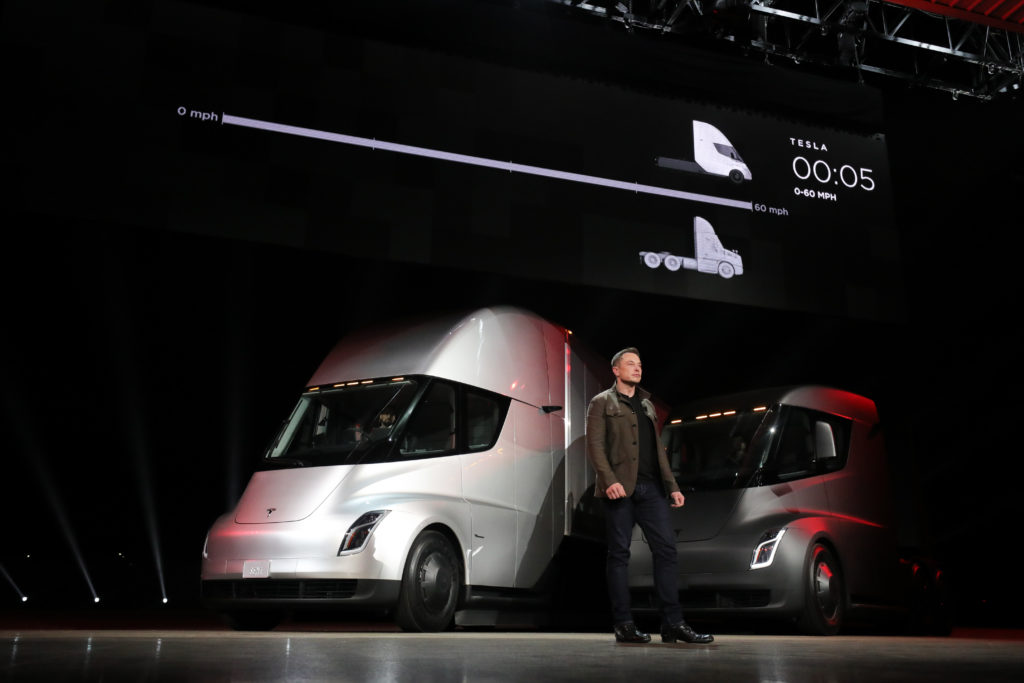
What We Don’t Know
What we don’t know is whether Musk and Co have something up their sleeves for the batteries. Much of the speculation regarding the Tesla Semi has been in regards to Tesla Semi’s massive battery pack.
In actuality, having a huge battery breakthrough on a vehicle like the Tesla Semi would not necessarily be a good thing for business. If there is a huge breakthrough, then all bets are off and most of our speculation in this article is moot. That would, however, mean that the sales potential of the Semi would be far lower than it would be otherwise because one thing that logistics companies and fleet managers aren’t interested in are flashy new, breakthrough, and (most importantly) untested, unproven technologies.
To a fleet manager, those phrases mean “breaks often, expensive to fix” and the potential positives will be ignored because of that. No one who wants to keep a job as a fleet manager or logistics purchaser will gamble on something unproven. Like new battery technology for a truck whose primary cost will be in its batteries. Likewise, unless there is a clear benefit in some terms other than pure business (like marketing or potential tax breaks), no board of directors will risk shareholder wrath on new tech either.
Close-up look at Tesla Semi’s drivetrain from underneath
We can say, as a side note, that most of the orders that have been placed for the Tesla Semi thus far are from corporations and companies who are doing business in areas where the marketing bonanza and potential tax incentives for laying down those relatively low-cost deposits are immense. Most of the companies involved have already invested heavily (and very publicly) in alternative fuel options outside of Tesla over the past few years. We also note the timing of both the Tesla Semi’s announcement (and order-taking) and the before-2018 rush by potential customers to put in deposits.
We reiterate that our not knowing if Tesla has some kind of big battery breakthrough announcement is a big “if” in our analysis here.
What People Smarter Than Us Have Said
Some people who know more than we do about things like math and engineering science have crunched the numbers on the Tesla Semi’s battery potentials. Over at Engineering.com, John Ewbank broke the results down into layman format. Here’s the gist.
If the Tesla Semi uses 2 kWh to travel a mile, then a 500-mile range means 1,000 kWh of power. That is not the actual size of the battery, though, as the charging requirement would preclude a huge pack.
In order to get 400 miles in thirty minutes of charging, Ewbank notes, the charger would have to be 1.6MW to achieve the 800kWh of promised charge in only 30 minutes. Charging at that rate is not possible because the result would be arching in the pack, which would surely be akin to the next Boring Company Flamethrower meme when Semi trucks begin to explode in flames during charging as a regular event. So the charging has to be split up.
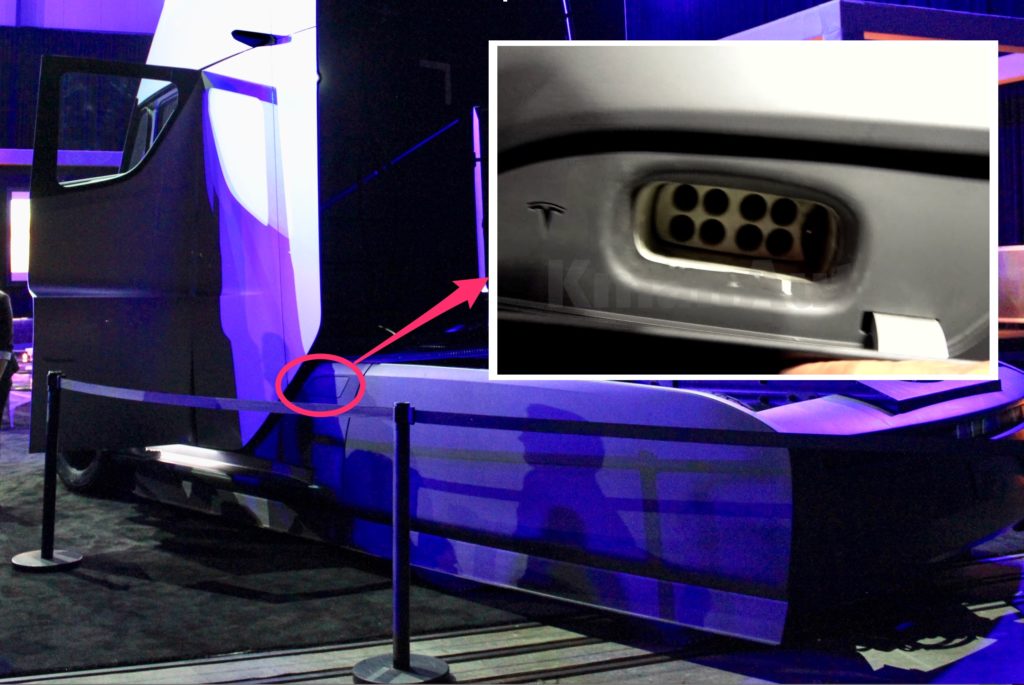
Tesla Semi Megacharger port could support 1 MW of power.
The answer is simple, of course, and may explain the strange layout of the eight-port charging hub shown on the Semi at its unveil: there are four battery packs.
Instead of one big pack, four smaller packs (one for each motor, even) are used and are thus charging separately from one another, but simultaneously. Based on Tesla Semi’s Megacharger port configuration, this would likely mean that four of them are positive sides and the other four are grounds. Allowing for a single, huge wire to be plugged into each. The controls for the charging system interface may be plugged in separately (perhaps the oval-shaped black thing to the side?).
What This Adds Up To
We add up that bit of information plus what we know about the truck and get an estimated weight. Using the current weight of a Tesla Model S battery pack at 540kg per 90 kWh, we can do some simple math to estimate the Semi’s batteries would weigh about 6,000 kg. We aren’t sure about the new battery weights for the upcoming battery updates, but we can assume a 10-15 percent reduction from several factors (storage density, improvements in chemistry, packaging lightening) without being too aggressive or overly optimistic. Going with the fifteen percent reduction, that 6,000 kg drops to 5,100 kg. That’s about 11,244 pounds.
A conventional tractor, as we’ve said, has a tare weight of around 32,000 pounds when fully fueled and with a lightweight box trailer in place. Remove the trailer and the truck itself is about 22,500 pounds. It’s difficult to then go to just the weight of the powertrain components and fuel, but they’re considerably less than 11,000 pounds in all.
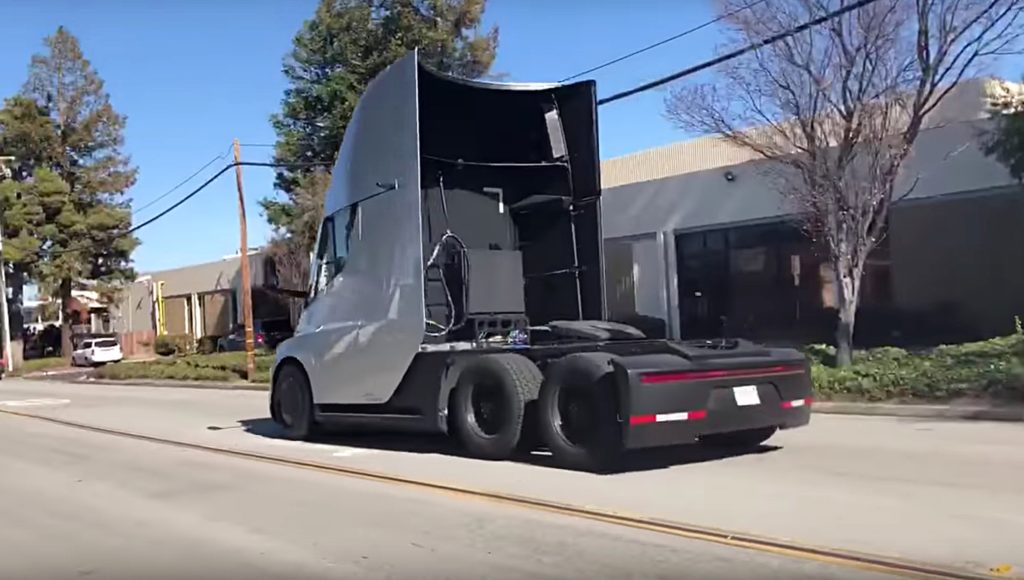
Tesla Semi spotted doing a tire-shredding acceleration run down in the wild
Looking at the shipping weight for a crated engine and transmission for a Class 8 truck, we can see that they weigh about 8,000 pounds on average. Add in fuel and other components and another 1,500 pounds (at most) are put on the truck. We then assume that the rest of the truck (framing, braking systems, air compressor, etc) are about the same for the Tesla Semi in order for it to meet Class 8 standards. So we call those a wash.
That means that the Semi, under our estimates, is roughly two tons heavier than would be a standard day cab big truck in the Class 8 category. This means the Semi would be that much less capable in terms of freight hauling that’s offset by its unprecedented all-electric performance. That amount, however, is probably not enough to stop the primary buyers of a day cab truck like this from balking at a purchase. The weight difference alone would be repaid in potential fuel savings, tax incentives, green marketing, and maintenance costs.
The trouble will come with cost differences. If the ROI is not there, most logistics buyers won’t write any purchase orders. But at least we can say that as far as we can tell, the weight differences of the Tesla Semi alone aren’t going to be a huge bar against entry into the trucking industry.

News
Elon Musk’s Grokipedia surges to 5.6M articles, almost 79% of English Wikipedia
The explosive growth marks a major milestone for the AI-powered online encyclopedia, which was launched by Elon Musk’s xAI just months ago.

Elon Musk’s Grokipedia has grown to an impressive 5,615,201 articles as of today, closing in on 79% of the English Wikipedia’s current total of 7,119,376 articles.
The explosive growth marks a major milestone for the AI-powered online encyclopedia, which was launched by Elon Musk’s xAI just months ago. Needless to say, it would only be a matter of time before Grokipedia exceeds English Wikipedia in sheer volume.
Grokipedia’s rapid growth
xAI’s vision for Grokipedia emphasizes neutrality, while Grok’s reasoning capabilities allow for fast drafting and fact-checking. When Elon Musk announced the initiative in late September 2025, he noted that Grokipedia would be an improvement to Wikipedia because it would be designed to avoid bias.
At the time, Musk noted that Grokipedia “is a necessary step towards the xAI goal of understanding the Universe.”
Grokipedia was launched in late October, and while xAI was careful to list it only as Version 0.1 at the time, the online encyclopedia immediately earned praise. Wikipedia co-founder Larry Sanger highlighted the project’s innovative approach, noting how it leverages AI to fill knowledge gaps and enable rapid updates. Netizens also observed how Grokipedia tends to present articles in a more objective manner compared to Wikipedia, which is edited by humans.
Elon Musk’s ambitious plans
With 5,615,201 total articles, Grokipedia has now grown to almost 79% of English Wikipedia’s article base. This is incredibly quick, though Grokipedia remains text-only for now. xAI, for its part, has now updated the online encyclopedia’s iteration to v0.2.
Elon Musk has shared bold ideas for Grokipedia, including sending a record of the entire knowledge base to space as part of xAI’s mission to preserve and expand human understanding. At some point, Musk stated that Grokipedia will be renamed to Encyclopedia Galactica, and it will be sent to the cosmos.
“When Grokipedia is good enough (long way to go), we will change the name to Encyclopedia Galactica. It will be an open source distillation of all knowledge, including audio, images and video. Join xAI to help build the sci-fi version of the Library of Alexandria!” Musk wrote, adding in a later post that “Copies will be etched in stone and sent to the Moon, Mars and beyond. This time, it will not be lost.”
News
Tesla Model 3 becomes Netherlands’ best-selling used EV in 2025
More than one in ten second-hand electric cars sold in the country last year was a Tesla Model 3.

The Tesla Model 3 became the most popular used electric car in the Netherlands in 2025, cementing its dominance well beyond the country’s new-car market.
After years at the top of Dutch EV sales charts, the Model 3 now leads the country’s second-hand EV market by a wide margin, as record used-car purchases pushed electric vehicles further into the mainstream.
Model 3 takes a commanding lead
The Netherlands recorded more than 2.1 million used car sales last year, the highest level on record. Of those, roughly 4.8%, or about 102,000 vehicles, were electric. Within that growing segment, the Tesla Model 3 stood far ahead of its competitors.
In 2025 alone, 11,338 used Model 3s changed hands, giving the car an 11.1% share of the country’s entire used EV market. That means more than one in ten second-hand electric cars sold in the country last year was a Tesla Model 3, Auto Week Netherlands reported. The scale of its lead is striking: the gap between the Model 3 and the second-place finisher, the Volkswagen ID3, is more than 6,700 vehicles.
Rivals trail as residual values shape rankings
The Volkswagen ID.3 ranked a distant second, with 4,595 used units sold and a 4.5% market share. Close behind was the Audi e-tron, which placed third with 4,236 registrations. As noted by Auto Week Netherlands, relatively low residual values likely boosted the e-tron’s appeal in the used market, despite its higher original price.
Other strong performers included the Kia Niro, the Tesla Model Y, and the Hyundai Kona, highlighting continued demand for compact and midsize electric vehicles with proven range and reliability. No other model, however, came close to matching the Model 3’s scale or market presence.
News
Tesla Model Y Standard Long Range RWD launches in Europe
The update was announced by Tesla Europe & Middle East in a post on its official social media account on X.

Tesla has expanded the Model Y lineup in Europe with the introduction of the Standard Long Range RWD variant, which offers an impressive 657 km of WLTP range.
The update was announced by Tesla Europe & Middle East in a post on its official social media account on X.
Model Y Standard Long Range RWD Details
Tesla Europe & Middle East highlighted some of the Model Y Standard Long Range RWD’s most notable specs, from its 657 km of WLTP range to its 2,118 liters of cargo volume. More importantly, Tesla also noted that the newly released variant only consumes 12.7 kWh per 100 km, making it the most efficient Model Y to date.
The Model Y Standard provides a lower entry point for consumers who wish to enter the Tesla ecosystem at the lowest possible price. While the Model 3 Standard is still more affordable, some consumers might prefer the Model Y Standard due to its larger size and crossover form factor. The fact that the Model Y Standard is equipped with Tesla’s AI4 computer also makes it ready for FSD’s eventual rollout to the region.
Top Gear’s Model Y Standard review
Top Gear‘s recent review of the Tesla Model Y Standard highlighted some of the vehicle’s most notable features, such as its impressive real-world range, stellar infotainment system, and spacious interior. As per the publication, the Model Y Standard still retains a lot of what makes Tesla’s vehicles well-rounded, even if it’s been equipped with a simplified interior.
Top Gear compared the Model Y Standard to its rivals in the same segment. “The introduction of the Standard trim brings the Model Y in line with the entry price of most of its closest competition. In fact, it’s actually cheaper than a Peugeot e-3008 and costs £5k less than an entry-level Audi Q4 e-tron. It also makes the Ford Mustang Mach-E look a little short with its higher entry price and worse range,” the publication wrote.
